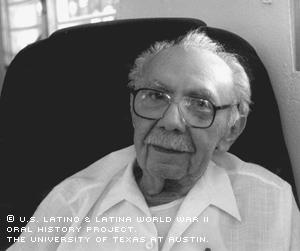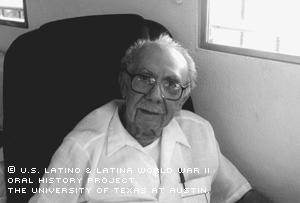

By Doralis Perez-Soto
In December 1941, 18-year-old José Blas García traveled from his neighborhood of Trastalleres, an area among the swamps and mangrove trees near Caño de Martín Peña in Santurce, Puerto Rico, with four friends to enlist in the military at Fort Buchanan, Puerto Rico. Of the five, only two were chosen, and young García was one of them. He says he had nothing better to do at the time.
From then until December of 1945, he served in the U.S. Army -- training at camps in Tortuguero, Cayey, Salinas and Buchanan. In Cayey, he trained with live ammunition; in Salinas, he underwent physical training. García recalls that at the Salinas camp, the men slept on the floor, fearful of spiders.
After several months of training, García was assigned to the L Company of the 65th Infantry Regiment of the Puerto Rican National Guard. They were stationed in Puerto Rico, and the unit's work was mostly guard duty and maintenance.
In January of 1943, they moved to Fort Clayton, Panama. The soldiers' duties included 24-hour guard shifts, watching locks on the canal and transporting soldiers between different sites in Panama, such as Río Hato.
That period, García says, was "good and bad, like being in Puerto Rico." He added that in Panama, "they talk bad; they call refreshments 'chicha.'"
From Panama, Garciía traveled by ship to the United States, to New Orleans, arriving on Jan. 21, 1944. The unit again began training, at Camp Patrick Henry in Virginia, for their new destination: Italy. They departed Hampton Roads, Va., on March 26, 1944, and stopped in North Africa on April 5, 1944.
The regiment then separated, with the majority going into Southern France and Garcia's 3rd Battalion going to the island of Corsica to work with the 12th U.S. Army Air Force. The 3rd Battalion of the 65th then went to the Italian Maritime Alps for the remainder of the war in Europe.
García landed in Monte Casino, where he worked in security and helped clean the area and the statues that adorned the palace. Monte Casino was the site of Allied bombing to repel the Germans occupying the area.
After several months in Italy, García and his fellow soldiers moved toward France. However, a storm tossed the men's ship, forcing them to cut the engines and let the vessel take its own course. The trip was particularly dangerous because the boat also carried explosives, chiefly mines.
After docking safely, the men traveled to the French Alps, where Garci¬a's duty was to guard the snowy peaks 1,600 feet above sea level. In those extreme conditions, Garci¬a says he had several disagreements with the Puerto Rican chain of command; he felt that some of the orders put the soldiers, including himself, in danger.
Garci¬a says he went without a bath for a month and developed an infection in his right hand that debilitated it. Because of that, he was sent to a hospital where he was given antibiotics; the diet at the hospital, he says, consisted of hot dogs and water.
During his time in the service, Garcia sent part of his monthly salary to his parents. When he first enlisted, he earned $21 a month; later, when he arrived in Germany and had been promoted to Staff Sergeant, he earned $300 a month. The money he sent to his parents helped them buy a house in the town of Santurce.
García was born on Día de San Blas (Saint Blaise Day), Feb. 3, 1921. His mother died when he was 6 years old, and his father moved him and his siblings from the town of Vega Alta to Santurce, and then to the city of San Juan. In San Juan, the elder Garci¬a, who’d worked in the sugar cane industry, began to work as a guard, and eventually remarried. Young García was close to his father and stepmother, so much so that he says he had two mothers.
As a child, young García played tops and a game with large marbles, and walked 7 1/2 miles to school until he got to the 8th grade. He recalls eating breakfasts of "a piece of baked sweet potato and a bit of coffee." Lunch was tropical tubers, such as yuca and milk. And at school, he bought a sandwich with a bit of butter.
On the Día de los Reyes, or Epiphany, he’d put grass in a shoebox, as was the custom in Puerto Rico, and receive a gift. His sisters received small and dark-complected dolls, he says.
Life in the city was difficult. García’s family lived in a house that had no running water or electricity. On Saturdays, they’d go to the beach to bathe; their drinking water was polluted by the soap being used up-river by women washing clothes, he says.
While serving in France during World War II, García also was stationed on the island of Córcega, where he worked in aviation. On one occasion, a plane was flying over the base, looking for a place to land. García signaled an area to land, but the plane crashed, and the only survivor was a badly wounded Puerto Rican copilot. This young man refused to give up, García said, and preferred to be left in battle, asking only that his next plane have the Puerto Rican flag painted on it. Garcia says he never learned whether the aviator's wishes were granted, but that he remembers the man's determination.
In Heidelberg, Germany, García shot a German who was trying to rob a warehouse of food. The German died, and a Puerto Rican general tried to bring charges against Garcia. However, Garci¬a communicated with the American military authorities -- using body language to explain himself, as he didn’t speak good English and they spoke no Spanish -- and was exonerated of all charges.
After learning of the end of the war in Germany, García traveled by Jeep to Marseilles, and six days later, shipped out to Puerto Rico.
Upon returning in December of 1945, García says he found Puerto Rico changed; for example, there were more cement buildings, including his parents' home. He took advantage of the GI Bill to return to school, then worked selling insurance. García married sometime in the 1940s -- he says he doesn’t recall the exact year. He and his wife, María Mercedes Rodri¬guez-Ramos, had one son and adopted two more children.
María died of a heart attack in 1998. At the time of his interview, García lived with his sister and spent time with his daughters.
Mr. García was interviewed in San Juan, Puerto Rico, on February 6, 2003, by Doralis Perez-Soto.

